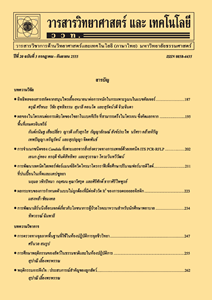Analysis of Hyperthyroidism Mathematical Model
Main Article Content
Abstract
In this research, we study a mathematical model of the regular process of thyroid gland and develop a mathematical model for the process of the thyroid gland in hyperthyroidism condition including terms for the effect from medical treatment. The proposed model is a system of 3 nonlinear differential equations. We analyze and find the parameters that stabilize the system of the developed model. Moreover, we simulate the model to test the parameters obtained from the analysis. We can clearly show, with respect to time, the level of T4 hormone, which can indicate the thyroid gland abnormality. Via the developed model, we analyze T4 hormone level in 3 cases: (1) no medical treatment, (2) constant treatment, and (3) time dependent treatment. The results show that T4 hormone can be reduced to normal level in all cases. However, the time for T4 hormone to be reduced to that level is 8 months in the case of no medical treatment and 6 months for the latter two cases.
Article Details
References
Simon, D.L., Lee, S.Y. and Braverman, L.E., 2016, Hyperthyroidism, Lancet 388: 906-918.
Degon, M., Chipkin, S.R., Hollot, C.V., Zoeller, R.T and, Chait, Y., 2007, A computational model of the human thyroid, Math. Biosci. 212: 22-53.
Balykina, Y.E., Kolpak, E.P. and Kotina, E.D., 2014, Mathematical model of thyroid function, Middle East J. Sci. Res. 19: 429-433.
King, A.C., Billingham, J. and Otto, S.R., 2003, Differential Equation: Linear, Nonlinear, Ordinary, Partial, Cambridge University Press, Cambridge, 541 p.
Azizi, F. and Malboosbaf, R., 2017, Long-term antithyroid drug treatment: A systematic review and meta-analysis, Thyroid 27: 1223-1231.
Katagiri, R., Yuan, X., Kobayashi, S. and Sasaki, S., 2017, Effect of excess iodine intake on thyroid diseases in different populations: A systematic review and meta-analyses including observational studies, PLoS ONE 12(3): e0172733.
Balamurugan, P., 2009, Mathematical Modeling and Dynamical Analysis of the Operation of the Hypothalamus-Pituitary-Thyroid (HPT) Axis in Autoimmune (Hashimoto’s) Thyroiditis, Doctoral Dissertation, Marquette University, Milwaukee, 67 p.
Bahn, R.S., Burch H.B., Cooper, D.S., Garber, J.R., Greenlee, M.C., Klein, I., Laurberg, P., McDougall, I.R., Montori, V.M., Rivkees, S.A., Ross, D.S., Sosa, J.A. and Stan, M.N., 2011, Hyperthyroidism and other causes of thyrotoxicosis: Management guidelines of the American Thyroid Association and American Association of Clinical Endocrinologists, Endoc. Pract. 17:456-520.


